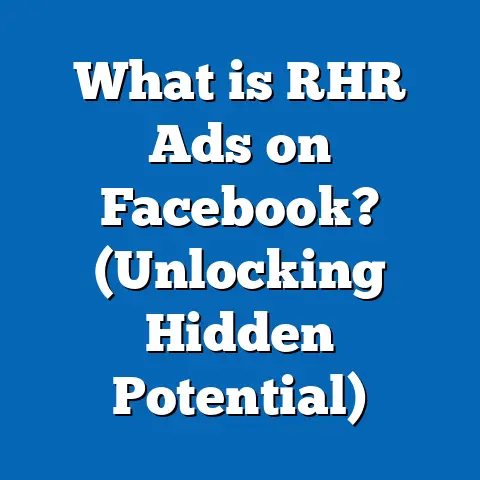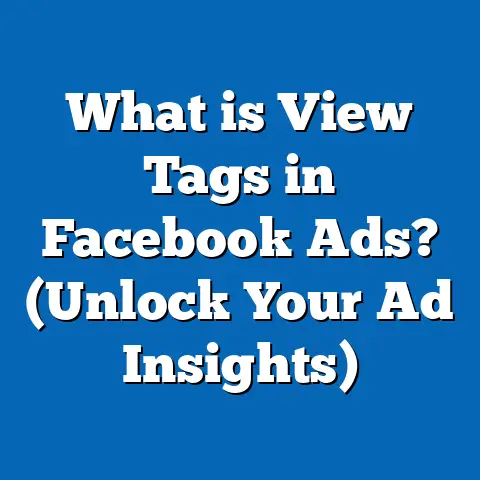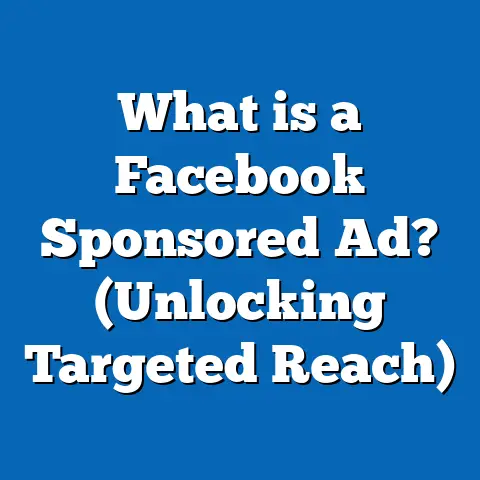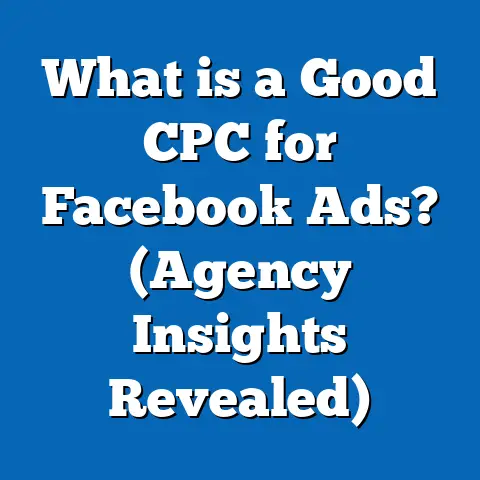What is Facebook Reach Ad? (Unlock Maximum Visibility!)
What is Facebook Reach Ad? (Unlock Maximum Visibility!)
Introduction: Why Should You Care About Facebook Reach Ads?
Imagine you pour your heart, time, and money into creating a compelling Facebook ad campaign—but it barely gets seen. Your target audience scrolls past without noticing. Sound familiar? In a world where billions of people scroll through social media feeds daily, visibility is the lifeblood of any successful digital marketing effort.
Facebook Reach Ads are designed specifically to solve this visibility problem. They focus on maximizing how many unique people see your ads, rather than just driving clicks or engagement from a smaller group. If you want your brand to dominate awareness, build recognition, and lay the foundation for future conversions, understanding and mastering Facebook Reach Ads is a must.
In this guide, we’ll break down everything from the basics to expert strategies with data-driven insights and real-world examples. Whether you’re a seasoned marketer or a business owner looking to expand your digital footprint, this guide will help you unlock maximum visibility using Facebook Reach Ads.
What Are Facebook Reach Ads?
The Basics: Reach vs Impressions vs Frequency
Before diving into Facebook Reach Ads, it’s critical to understand three fundamental concepts in digital advertising:
- Reach: The number of unique individuals who see your ad at least once.
- Impressions: The total number of times your ad is shown—this can include multiple views by the same person.
- Frequency: How often, on average, each person sees your ad.
Facebook Reach Ads prioritize increasing the reach metric. This means your ad is shown to as many different people as possible within your target audience. It contrasts with other campaign types optimized for clicks, conversions, or engagement.
Why Focus on Reach?
Maximizing reach is essential for:
- Building brand awareness
- Launching new products or services
- Promoting events or offers
- Testing market response across a broad audience
By focusing on reach, you ensure your message touches the widest possible audience without overspending on repeated views to the same users.
Types of Reach on Facebook
Facebook offers two main options when it comes to reach objectives:
- Standard Reach: Aim to reach as many people as possible within your budget.
- Reach and Frequency: Allows advertisers to lock in predictable reach and frequency over a specified time period with guaranteed delivery.
The Reach and Frequency tool is especially useful for brand advertisers looking for greater control over how many people see their ads and how often.
How Does Facebook Measure Reach?
Facebook’s reporting distinguishes between several metrics related to reach:
- Unique Reach: Counts each user once regardless of how many times they see the ad.
- Daily Reach: The number of unique users who saw your ad on a given day.
- Lifetime Reach: The total unique users reached during the entire campaign period.
The platform uses anonymized user IDs to track ad views across devices and sessions. This helps ensure accuracy in measuring how many distinct individuals were exposed.
The Role of Frequency in Reach Measurement
Frequency is vital because it impacts how your reach translates into actual awareness and recall. For example, if your frequency is too low (1 or below), many users might see your ad once but fail to remember it. Too high a frequency can cause annoyance or ad fatigue.
Research shows that an optimal frequency range for brand awareness lies between 1.5 to 3 exposures per week per user. This balance maximizes message retention without causing negative sentiment.
Why Use Facebook Reach Ads?
Strategic Importance of Broad Visibility
When launching a new product or entering a new market segment, you need rapid exposure to build interest. Facebook Reach Ads help you do exactly that by showing your ads to as many potential customers as possible.
Data Point: Facebook reports that campaigns optimized for reach deliver up to 30% more unique impressions at a lower CPM (cost per thousand impressions) compared to campaigns optimized for clicks or conversions.
Brand Awareness: The Foundation of Marketing Funnels
Reach campaigns build the top of your marketing funnel by increasing brand recognition. According to Nielsen studies cited by Facebook IQ:
- Brands with higher awareness enjoy a lift in purchase intent by up to 22%.
- Reaching large audiences repeatedly builds familiarity and trust over time.
When Should You Use Reach Ads?
| Scenario | Why Choose Reach Ads |
|---|---|
| New product launch | To quickly spread awareness among potential buyers |
| Event promotion | To maximize attendance by exposing event details widely |
| Seasonal sales | To inform broad audiences about limited-time offers |
| Brand building campaigns | To increase overall recognition and recall |
| Market research campaigns | To test messaging across large audiences |
Budget Efficiency
Reach campaigns typically have lower CPMs because they focus on broad exposure rather than targeting high-intent clicks. This makes them ideal for businesses with modest budgets wanting maximum visibility per dollar spent.
How Do Facebook Reach Ads Work?
Facebook’s Delivery Algorithm Explained
The delivery system behind Facebook Reach Ads uses machine learning models that analyze:
- Your budget and bid strategy
- Audience size and demographics
- Ad quality and relevance score
- Competition for ad space in real-time auctions
The algorithm’s goal is to maximize your unique reach while staying within budget constraints. It dynamically adjusts bids and placements based on performance feedback.
Frequency Caps: Avoiding Overexposure
Frequency caps limit how often the same user sees your ad during a specific time frame. Setting these caps helps prevent:
- Ad fatigue
- Negative brand perception
- Wasted ad spend on redundant impressions
Ideal settings depend on campaign length and goals but generally fall between 1.5 and 3 impressions per week per user.
Targeting Options: Balancing Precision and Scale
You can fine-tune who sees your ads by using:
- Demographics (age, gender, language)
- Location (countries, states, cities)
- Interests (pages liked, hobbies)
- Behaviors (purchase habits, device usage)
- Custom Audiences (email lists, website visitors)
- Lookalike Audiences (people similar to existing customers)
Balancing specificity with audience size ensures you reach enough distinct people without diluting relevance.
Detailed Data Insights on Facebook Reach Ads
Cost Metrics: CPM and Cost Per Unique User
Cost efficiency is a major advantage of reach campaigns:
- Average CPM for reach campaigns ranges between $4–$8, depending on industry and competition.
- Cost per unique user tends to be 15–20% lower than campaigns optimized for clicks or conversion.
This cost structure makes reach ads excellent for initial brand exposure phases before driving direct actions like website visits or purchases.
Impact on Brand Awareness and Recall
According to a study by Nielsen Catalina Solutions:
- Campaigns optimized for reach achieved up to 70% lift in aided brand awareness.
- Higher frequency correlated positively with recall but plateaued after approximately 3 exposures per week.
Case Study: National Retailer Boosts Awareness with Reach Ads
Background: A national clothing retailer wanted to promote its summer collection across multiple states.
Approach: A 4-week campaign using Facebook Reach Ads targeted men and women aged 18-35 in urban areas with frequency capped at 2 per week.
Outcome:
- Reached over 5 million unique users
- Brand recall increased by 45% among surveyed participants
- Physical store visits rose by 18% during campaign duration
- Achieved CPM of $5.20, 17% lower than previous click-focused campaigns
This case highlights how reach ads can effectively increase visibility and drive offline actions.
Step-by-Step Guide: Creating Your First Facebook Reach Ad Campaign
Step 1: Set Up Your Campaign Objective
In Facebook Ads Manager:
- Click “Create”
- Select the Reach objective under Awareness
- Name your campaign clearly (e.g., “Summer Collection – Reach Campaign”)
Step 2: Define Your Target Audience
Use demographic filters like age, gender, location, languages spoken. Consider layering interests or behaviors for added precision without narrowing too much.
Pro tip: Start broad; refine based on performance data after initial tests.
Step 3: Budgeting and Scheduling
Choose between daily budget (spend clocked daily) or lifetime budget (spread over campaign duration).
Set start and end dates to control timing. For ongoing campaigns, monitor results weekly to adjust budgets.
Step 4: Configure Frequency Controls
In the “Ad Set” section:
- Enable frequency cap under “Advanced Options”
- Set limits such as “2 impressions every 7 days” or customize based on campaign length
Step 5: Design Your Creative Assets
Since reach ads aim for maximum exposure:
- Use bright, attention-grabbing visuals
- Keep text succinct and clear
- Include strong branding elements like logos or slogans
- Consider mobile-first formats like Stories or short videos
Step 6: Place Your Order and Monitor Performance
Launch the campaign. Use Facebook’s reporting dashboards to track:
- Total reach
- Frequency
- CPM
- Engagement metrics (likes/comments/shares)
Adjust targeting or creatives based on data insights during the campaign lifecycle.
Advanced Techniques for Optimizing Facebook Reach Ads
Combine Reach With Retargeting Funnels
Reach ads are excellent for initial exposure but may not convert immediately. Complement them with retargeting ads focused on:
- Website visitors
- Video viewers
- Engagement with previous ads
This layered approach nurtures awareness into action.
Lookalike Audiences: Expand Efficiently
Create lookalike audiences based on your top customers or website visitors:
- Select source audience of at least 1,000 people
- Choose similarity percentages (1% most similar is highly targeted)
- Use reach campaigns targeting these groups to scale efficiently
Optimize Placements for Maximum Exposure
Facebook offers multiple placements:
| Placement | Best Use Case |
|---|---|
| News Feed | High engagement and visibility |
| Stories | Mobile-first, immersive format |
| Audience Network | Extended reach outside FB |
| Instagram Feed | Younger demographics |
| Messenger | Direct user engagement |
Test combinations of placements to identify top performers for your audience.
Experiment With Ad Scheduling
Run ads during peak user activity hours identified through analytics tools like Facebook Insights or Google Analytics:
- Early morning (7am–9am) and evening (6pm–9pm) often show higher engagement
- Weekends vs weekdays—adjust according to business type
Scheduling reduces wasted impressions during low-engagement periods.
How Facebook Reach Ads Compare With Other Platforms’ Equivalent Strategies
Google Display Network (GDN) CPM Campaigns vs Facebook Reach Ads
| Feature | Google Display CPM Campaigns | Facebook Reach Ads |
|---|---|---|
| Audience Targeting | Keyword/context-based + demographics | Detailed demographics + interests |
| Visual Formats | Banner ads | Image/video/interactive formats |
| Cost Structure | Typically higher CPM | Generally lower CPM |
| Social Interaction | Minimal | Likes/comments/shares available |
Google is great for intent-based targeting across millions of websites; Facebook excels at social engagement paired with visual storytelling.
Instagram Reach Ads Through Facebook Interface
Because Instagram is owned by Meta, you can run reach campaigns across Instagram seamlessly through Facebook Ads Manager.
Instagram’s younger user base and visual emphasis make it ideal for fashion, lifestyle brands, and others targeting millennials/Gen Z.
Common Challenges With Facebook Reach Ads & Solutions
Challenge 1: Ad Fatigue & Frequency Mismanagement
Problem: Users get annoyed seeing the same ad repeatedly. Performance drops.
Solution: Rotate creatives regularly; use frequency caps strategically; monitor relevance score diligently.
Challenge 2: Budget Allocation Confusion
Problem: Overspending with little impact due to unclear goal setting.
Solution: Start small with controlled budgets; use reach metrics like CPM/Cost per Unique User to evaluate efficiency; scale based on data.
Challenge 3: Overly Narrow Targeting Limits Scale
Problem: Small audience size limits maximum reach achievable leading to higher CPMs.
Solution: Broaden interests slightly; use lookalike audiences; avoid excessive layering of filters initially.
Practical Examples & Real-world Applications of Facebook Reach Ads
Example 1: Nonprofit Awareness Campaign
A charity wanted to raise awareness about clean water initiatives globally. They used reach ads targeting globally interested users aged 25–45 with interests in philanthropy and sustainability.
Results:
- Reached over 3 million unique users in 2 weeks
- Donations increased by 14% compared to previous year’s campaign
- Cost per unique user reached was $3.75
This example shows how reach ads can amplify social causes efficiently.
Example 2: Tech Startup Product Launch
A startup launching a new app ran a reach campaign targeting tech-savvy millennials in key cities with frequency capped at 1.8 per week.
They combined this with retargeting ads focusing on app downloads after initial exposure.
Results:
- Reached 1.8 million users initially
- Achieved a 20% increase in app downloads during campaign period
- CPM was $6.50 with strong engagement rates
Expert Tips for Mastering Facebook Reach Ads
- Test Multiple Creatives Simultaneously: Run A/B tests of images, videos, headlines to find what resonates best.
- Use Clear Call-To-Actions (CTAs): Even if optimizing for reach, include CTAs that prepare users for next steps.
- Leverage Video Content: Videos tend to generate higher recall and engagement.
- Monitor Relevance Scores: Higher scores lower costs and increase reach efficiency.
- Analyze Post-Campaign Data: Use insights for refining future reach campaigns — focus on demographics that performed best.
- Stay Updated on Platform Changes: Facebook frequently updates algorithms; keeping abreast ensures you adapt strategies effectively.
- Combine Offline & Online Tactics: Use offline events or promotions aligned with online reach ads for integrated marketing impact.
Summary: Unlocking Maximum Visibility With Facebook Reach Ads
Facebook Reach Ads are powerful tools designed to maximize the number of unique people who see your advertising message. When used correctly, they:
- Provide cost-effective broad exposure
- Build strong brand awareness at scale
- Serve as a foundation for multi-stage marketing funnels
- Work well alongside retargeting and conversion campaigns
Understanding how reach works—from frequency management to audience targeting—and applying advanced strategies can significantly improve your advertising ROI on Facebook’s platform.
If you want your message seen by millions without breaking the bank, mastering Facebook Reach Ads should be at the top of your marketing strategy list.
Additional Resources & Next Steps
For marketers ready to implement this knowledge:





